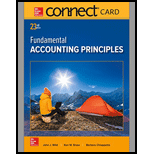
Concept Introduction:
Income Statement:
The income statement can be explained as the statement giving details about the revenues, incomes, gains and expenses, losses etc. The income statement is prepared to determine net income or loss of the business by listing all the revenues, gains and expenses and losses of the business.
Contribution margin income statement:
Contribution margin income statement can be defined as the income statement which explains elements like contribution margin from the sales unlike the traditional income statement.
Requirement 1
To prepare:
Departmental Income statement for 2017
Answer to Problem 8E
Solution:
The departmental Income statement for 2017 –
| Jansen Company | ||
| Ski Departmental Income Statement | ||
| Sales | 605,000 | |
| Less: Cost of Goods sold | 425,000 | |
| Gross profit | 180,000 | |
| Less: Other Operating Expenses | ||
| Salaries | 112,000 | |
| Utilities | 14,000 | |
| 42,000 | ||
| Office expenses | 20,000 | |
| Total operating expenses | 188,000 | |
| Net Operating Income (or Loss) | -8,000 | |
Explanation of Solution
The above explanation can be explained as under –
Given,
• Sales = $ 605,000
• Cost of goods sold = $ 425,000
• Salaries = $ 112,000
• Utilities = $ 14,000
• Depreciation = $ 42,000
• Office Expenses = $ 20,000
Gross profit –
Total Operating expenses –
Net Income (or loss) –
Thus, the departmental income statement has been prepared.
Requirement 2
To compute:
Department Contribution to
Answer to Problem 8E
Solution:
The department Contribution to overhead report = $ 40,000
Explanation of Solution
| Jansen Company | ||
| Ski Departmental Contribution Income Statement | ||
| Sales | 6,05,000 | |
| Less: Cost of Goods sold | 4,25,000 | |
| Gross profit | 1,80,000 | |
| Less: Other Operating Expenses -direct | ||
| Salaries | 97,000 | |
| Utilities | 11,000 | |
| Depreciation | 32,000 | |
| Total direct operating expense | 1,40,000 | |
| Net Contribution margin | 40,000 | |
The above contribution income statement provides net contribution of $ 40,000. The preparation of department contribution income statement can be explained as under –
Given,
• Sales = $ 605,000
• Cost of goods sold = $ 425,000
Only direct expenses are considered –
• Salaries = $ 97,000 (i.e. $ 97,000 as direct, as $ 15,000 is indirect)
• Utilities = $ 11,000 (i.e. $ 11,000 as direct, as $ 3,000 is indirect)
• Depreciation = $ 32,000(i.e. $ 32,000 as direct, as $ 10,000 is indirect)
• Office Expenses = $ 0 (i.e. all of the cost is indirect)
Gross profit –
Total Operating expenses –
Net Contribution Margin –
Thus, the contribution of Ski to overhead report has been determined.
Requirement 3
To decide:
Should Jansen eliminate the ski department?
Answer to Problem 8E
Solution:
No, Jansen should not eliminate the ski department as it is giving a positive contribution of $ 40,000 to the business.
Explanation of Solution
The above answer can be explained as under –
The Ski department is giving a positive contribution to Jansen as $ 40,000. If all of the total expenses whether direct or indirect are taken together, Ski department has a net operating loss of $ 8,000 but if only direct expenses are considered, there is positive contribution of $ 40,000 to the business.
Thus, keeping in mind this fact, Jansen should not eliminate the Ski Department from the business.
Thus, Jansen should not eliminate the ski department as it is giving a positive contribution of $ 40,000 to the business.
Want to see more full solutions like this?
Chapter 24 Solutions
Connect Access Card for Fundamental Accounting Principles
- I need help solving this general accounting question with the proper methodology.arrow_forwardPlease explain the solution to this general accounting problem using the correct accounting principles.arrow_forwardI need help finding the accurate solution to this financial accounting problem with valid methods.arrow_forward
- Please explain the solution to this financial accounting problem with accurate explanations.arrow_forwardI am looking for the correct answer to this general accounting question with appropriate explanations.arrow_forwardPlease provide the answer to this general accounting question using the right approach.arrow_forward

 AccountingAccountingISBN:9781337272094Author:WARREN, Carl S., Reeve, James M., Duchac, Jonathan E.Publisher:Cengage Learning,
AccountingAccountingISBN:9781337272094Author:WARREN, Carl S., Reeve, James M., Duchac, Jonathan E.Publisher:Cengage Learning, Accounting Information SystemsAccountingISBN:9781337619202Author:Hall, James A.Publisher:Cengage Learning,
Accounting Information SystemsAccountingISBN:9781337619202Author:Hall, James A.Publisher:Cengage Learning, Horngren's Cost Accounting: A Managerial Emphasis...AccountingISBN:9780134475585Author:Srikant M. Datar, Madhav V. RajanPublisher:PEARSON
Horngren's Cost Accounting: A Managerial Emphasis...AccountingISBN:9780134475585Author:Srikant M. Datar, Madhav V. RajanPublisher:PEARSON Intermediate AccountingAccountingISBN:9781259722660Author:J. David Spiceland, Mark W. Nelson, Wayne M ThomasPublisher:McGraw-Hill Education
Intermediate AccountingAccountingISBN:9781259722660Author:J. David Spiceland, Mark W. Nelson, Wayne M ThomasPublisher:McGraw-Hill Education Financial and Managerial AccountingAccountingISBN:9781259726705Author:John J Wild, Ken W. Shaw, Barbara Chiappetta Fundamental Accounting PrinciplesPublisher:McGraw-Hill Education
Financial and Managerial AccountingAccountingISBN:9781259726705Author:John J Wild, Ken W. Shaw, Barbara Chiappetta Fundamental Accounting PrinciplesPublisher:McGraw-Hill Education





